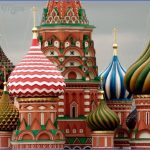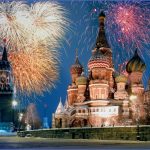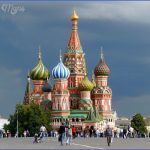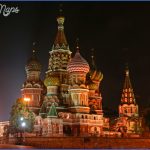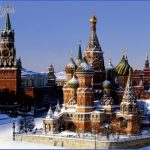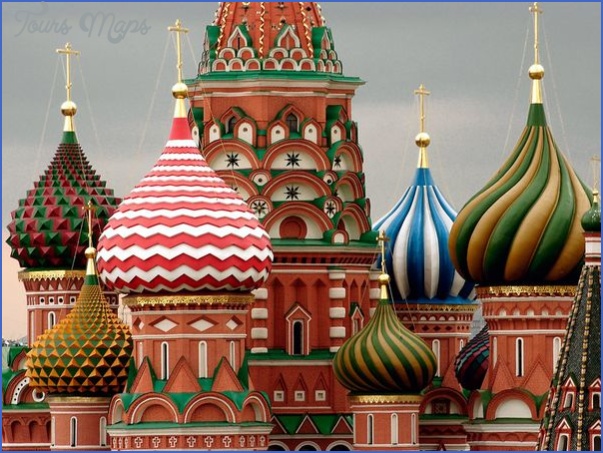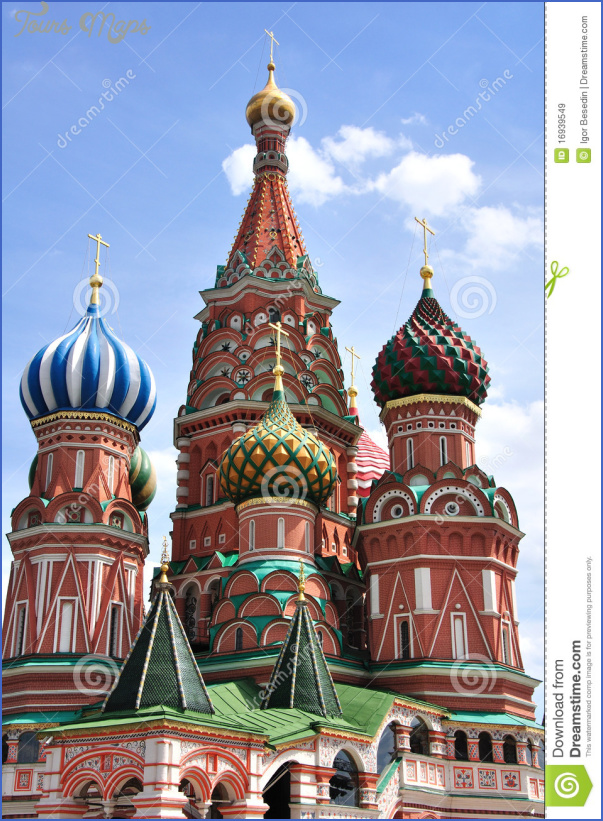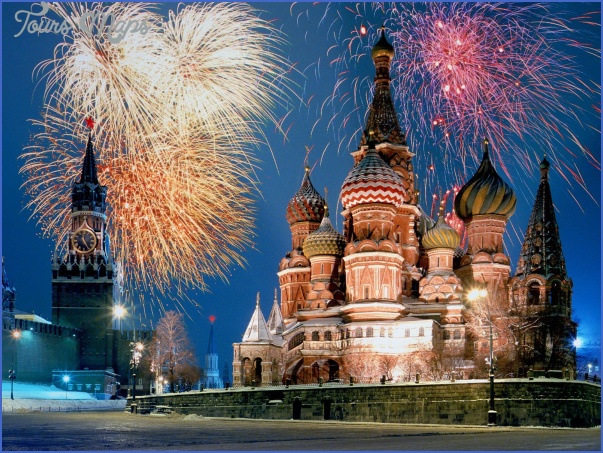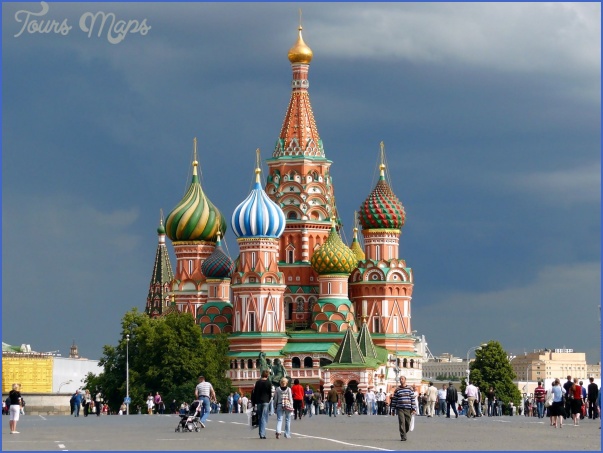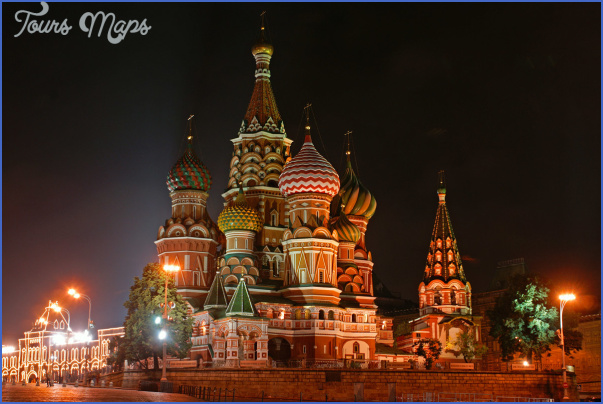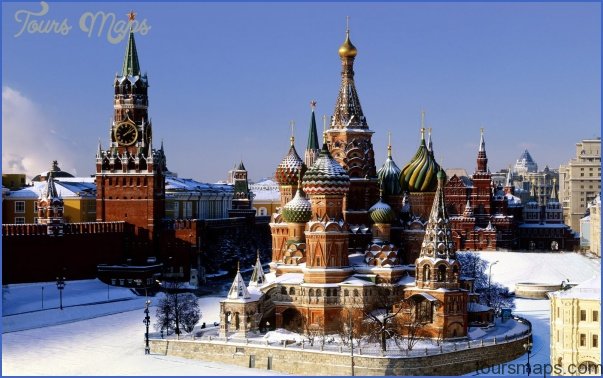POSTNIK YAKOVLEV
This unique building, usually known as St. Basil’s Cathedral, but more correctly called the Cathedral of the Protection of Most Holy Theotokos on the Moat, is one of Russia’s most distinctive sights. Built by Tsar Ivan IV (Ivan the Terrible) to commemorate his defeat of the Mongols at the Battle of Kazan in 1552, it stands just outside the Kremlin in Red Square, in the heart of Moscow. Its extraordinary onion-shaped domes, painted in bright colors, create a memorable skyline, making St. Basil’s a symbol both of Moscow and of Russia as a whole.
Although the cathedral looks asymmetrical from the outside, with its domes rising apparently at random, the plan of the building is in fact highly structured. The main church stands at the center and eight chapels are arranged around it four at the cardinal points of the compass, and a further four between them.
Each of these side chapels has its own distinctive tower, capped by an onion dome, and is linked to the others by narrow, winding passages. This plan is based on an eight-pointed star a potent Christian symbol because it is the shape of the New Jerusalem as described in the Book of Revelation. The Virgin Mary is also often shown in the paintings and icons of the Orthodox churches wearing a veil decorated with eight-pointed stars.
The planning and design of the building are unusual, and little is known about the architect said to be responsible for it. Some historians have found the building’s architectural roots in the wooden churches built in northern Russia in the period before this cathedral was constructed. They were possibly also influenced by the domed churches of the Byzantine empire (see pp.32-37), while certain details, such as the brickwork in the vaults, suggest that some of the builders may have come from western or central Europe.
IVAN IV c. 1530-84
Known in the West as Ivan the Terrible, the Muscovite prince Ivan IV was the first person to be crowned Tsar of all Russia, a title he took in 1547. He began his reign with legal and governmental reforms, forming assemblies of the nobility and restructuring local government in the provinces. He also developed Russian trade and led successful military campaigns against the Khanates of Kazan, Siberia, and Astrakhan, hugely expanding his power and turning Russia into a vast empire. His later reign was, however, dogged by problems. After his first wife died and Ivan himself survived a serious illness, the Tsar suspected nobles of killing the Empress and trying to poison him. He cracked down on their power, launched costly wars, and massacred his enemies in Russia. His reign ended in terror, but he left a legacy of centralized power that influenced the way Russia was ruled for centuries.
1 CENTRAL SPIRE A tall brick spire crowns the central church at the heart of the cathedral. It is raised up on an octagonal brick tower and soars above the rest of the building. The architects based this shape on that of Russian churches, such as the church of the Ascension at Kolomenskoye, which was built in 1532 and also has a tall octagonal spire. St. Basil’s spire, however, has an additional small onion dome, which enhances the skyline.
1500-1700 Visual tour
4 BRICKWORK It is easy to miss the fact that this polychrome building is a masterpiece of brickwork. Millions of bricks must have been used in the construction of St. Basil’s, including some specially made to create the intricate details of the towers and fagades. This section from one of the towers has a repeating motif of brick arches, some of which have circular brickwork openings inside. Smaller arches link the large ones.
ON DESIGN
The cathedral has gone through several phases of decoration. Early in its history, parts of the building were plastered and covered with fresco decoration that imitated brickwork, while others were adorned with floral murals, many of which date from the 17th century. 19th-century restorers added a number of murals in oil-based paints. More recent conservationists have removed these and restored the original floral decorations, replacing them where necessary.
1 Flower motif
This mural on the entrance wall dates from a recent restoration and reproduces 17th-century work.
4 DOME DETAIL Each of the domes has its own dazzling form of decoration, ranging from prisms and spirals to chevrons and stripes, all emphasized with brilliant colors. The color is unusual most Russian domes are either plain or gilded. Originally, the domes at St. Basil’s had a gold finish with some blue and green ceramic decoration. The bright, painted colors were added at various times from the 17th to the 19th century.
1 GALLERY The cathedral’s interior was extended in the 1680s, when builders walled in an open arcade that ran around the outside. This created a gallery, in which altars taken from 13 nearby wooden churches were placed. At the same time, artists adorned the passages within the cathedral with murals, mostly with curvaceous designs of flowering plants.
3 CENTRAL CHURCH The cathedral’s central church is dedicated to the Intercession of the Most Holy Theotokos (God-bearer, a Greek title used for the Virgin Mary in Orthodox churches). It is larger inside than the surrounding chapels but is still compact. It is narrow and extremely tall the ceiling is some 150ft (46m) above the floor.
The octagonal “drum” of brick increases the height of the dome
This onion dome was originally tin-clad and is now covered in painted copper
This is the dome of one of the eight chapels arranged around the central church
A short spire marks the church dedicated to St. Basil
Brickwork patterns adorn the walls
4 WALL OF ICONS
The iconostasis (a wall or screen of icons) stands between the nave and sanctuary in Orthodox churches. It separates the public space of the nave from the church’s holiest part, which is mainly the domain of the priests. The icons depict Jesus Christ, the Virgin Mary, saints, and the Apostles. They are traditionally displayed in five tiers, and a set of rules dictates their exact arrangement.
The outer “galleries” were walled in during the 17th century
St. Basil’s Cathedral MOSCOW, RUSSIA Photo Gallery
Maybe You Like Them Too
- The Best Cities To Visit in The World
- World’s 10 Best Places To Visit
- Coolest Countries in the World to Visit
- Travel to Santorini, Greece
- Map of Barbados – Holiday in Barbados

